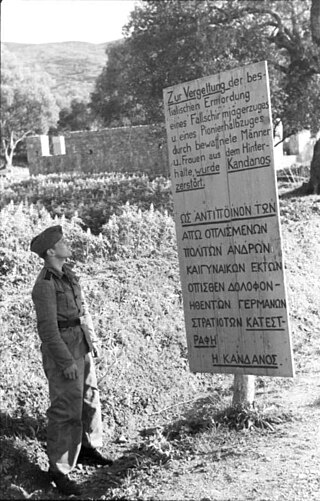
The Lidice massacre was the complete destruction of the village of Lidice in the Protectorate of Bohemia and Moravia, which is now a part of the Czech Republic, in June 1942 on orders from Nazi leader Adolf Hitler and acting Reichsprotektor Kurt Daluege, successor to Reinhard Heydrich. It has gained historical attention as one of the most documented instances of German war crimes during the Second World War, particularly given the deliberate killing of children.

On 10 June 1944, four days after D-Day, the village of Oradour-sur-Glane in Haute-Vienne in Nazi-occupied France was destroyed when 643 civilians, including non-combatant men, women, and children, were massacred by a German Waffen-SS company as collective punishment for Resistance activity in the area including the capture and subsequent execution of Waffen SS Sturmbannfuhrer Helmut Kämpfe, who an informant claimed had been burned alive in front of an audience. Kämpfe was a highly decorated commander in the 2nd SS Panzer Division Das Reich.

The National Front for an Independent France, better known simply as National Front was a World War II French Resistance movement created to unite all of the resistance organizations together to fight the Nazi occupation forces and Vichy France under Marshall Pétain.

The Marzabotto massacre, or more correctly, the massacre of Monte Sole, was a World War II war crime consisting of the mass murder of at least 770 civilians by Nazi troops, which took place in the territory around the small village of Marzabotto, in the mountainous area south of Bologna. It was the largest massacre of civilians committed by the Waffen SS in western Europe during the war. It is also the deadliest mass shooting in the history of Italy.

Telavåg or Tælavåg is a village in Øygarden municipality in Vestland county, Norway. The village is located on the island of Sotra, about 39 kilometres southwest of the city of Bergen. The 0.81-square-kilometre village has a population (2019) of 581 and a population density of 717 inhabitants per square kilometre (1,860/sq mi).

The 2nd SS Panzer Division Das Reich or SS Division Das Reich was an armored division of the Waffen-SS of Nazi Germany during World War II.

Ležáky, in the Miřetice municipality, was a village in Czechoslovakia. During the German occupation of Czechoslovakia, it was razed by Nazi forces as reprisal for Reich Protector Reinhard Heydrich's assassination in late spring 1942.
Khatyn was a village of 26 houses and 157 inhabitants in Belarus, in Lahoysk Raion, Minsk Region, 50 km away from Minsk. On 22 March 1943, almost the entire population of the village was massacred by the Schutzmannschaft Battalion 118 in retaliation for an attack on German troops by Soviet partisans.

Sylvester Stadler was a high-ranking Austrian commander of the Waffen-SS, a commander of the SS Division Hohenstaufen, previously having been the commander of the SS regiment whose 3rd Company was responsible for the Oradour-sur-Glane massacre. Only 34 years old at the end of the war, he held the rank of SS-Brigadeführer and generalmajor of the Waffen SS and was a recipient of the Knight's Cross with Oak Leaves.

Heinz Barth was a mid-ranking member in the Waffen-SS of Nazi Germany during World War II. He was a convicted war criminal who was responsible for the Oradour-sur-Glane massacre of 1944.
Maillé is a commune in the central French department of Indre-et-Loire.

Robert Hébras was one of only six people to survive the massacre of Oradour by Nazi Germany's Waffen-SS Das Reich Panzer Division on 10 June 1944.

Heinz Lammerding was a German SS officer convicted of war crimes during the Nazi era. During World War II, he commanded the SS Panzer Division Das Reich that perpetrated the Tulle and the Oradour-sur-Glane massacres in occupied France. After the war, Lammerding was convicted in absentia for having ordered the murder of approximately 750 French civilians, but remained protected by Germany after serving a prison sentence there.

Helmut Kämpfe was a Waffen-SS Sturmbannführer who was captured and executed by the French Resistance. In retribution, the Germans carried out the Oradour massacre in occupied France on 10 June 1944. In total 643 men, women and children were killed in Oradour-sur-Glane by troops from the 2nd SS Panzer Division Das Reich. Adolf Diekmann, the SS commander who ordered the massacre, said the death of Kämpfe was the reason for the killings.

The Razing of Kandanos refers to the complete destruction of the village of Kandanos in Western Crete (Greece) and the killing of about 180 of its inhabitants on 3 June 1941 by German occupying forces during World War II.

Adolf Rudolf Reinhold Diekmann was a Nazi officer in the Waffen SS during World War II who orchestrated the Oradour-sur-Glane massacre in France on 10 June 1944. Under Diekmann's command, troops from the SS Division Das Reich killed 643 inhabitants in the village, most of whom were women and children. He said he committed the war crime in retaliation to the killing of a fellow SS officer named Helmut Kämpfe by the French Resistance.

Oradour-sur-Glane is a commune in the Haute-Vienne department, New Aquitaine, west central France, as well as the name of the main village within the commune.

Lidice is a municipality and village in Kladno District in the Central Bohemian Region of the Czech Republic. It has about 600 inhabitants.

The Memorial Centre Lipa Remembers is a museum commemorating the killing of 269 civilians - mostly elderly, women and children - in April 1944 in Lipa, Croatia. The massacre was perpetrated by the German military, together with Italian and Chetnik collaborationist forces.
The Ivanci massacre was the complete destruction of the Serb village of Ivanci in eastern Croatia on 30 November 1943 by Nazi German forces.




















